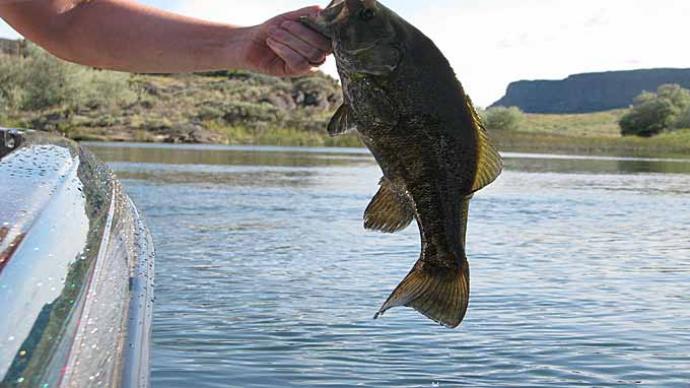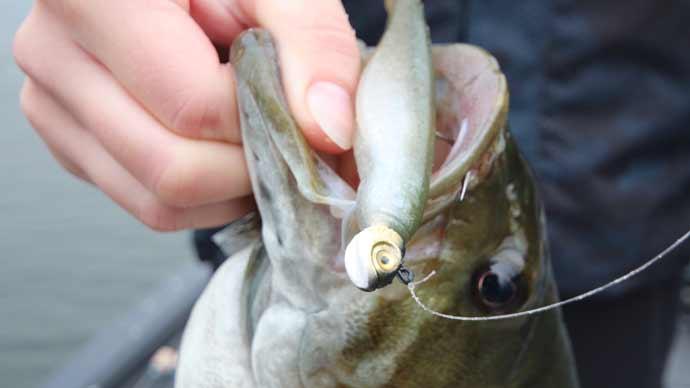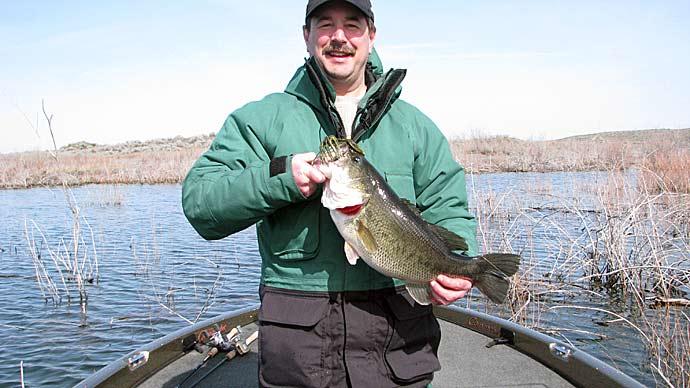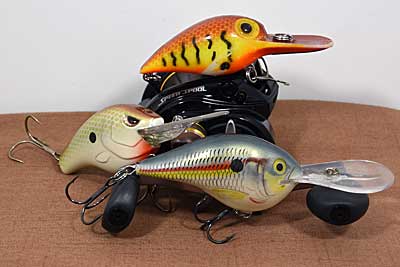
There is a myth in bass fishing that you should put your crankbait box away when the water temperatures start to go down during the fall season, as the cranking season is done. That isn't true. You can still catch bass on crankbaits late into the fall/winter season, but you will have to make modifications as to how and where you fish crankbaits. Let’s look at cranking situations up North and down South for fishing crankbaits late into the season.
Northern Late Season Cranking
On a cold Fall, Saturday my fishing partner and I were on the water trying to fish late into the season up in my home state of Minnesota. We always start the fishing season with a goal that if we can be on the water till Thanksgiving, we have reached our goal. Well, we made it to the Sunday before Thanksgiving, and we were still on the water. During that day of fishing, we were catching bass located in and on the edge of the green coontail weeds in about 13ft to 15ft of water on jig-n-pig.
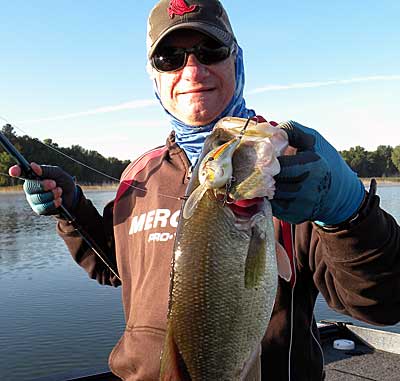
It was not a fast-paced day as water temps were touching the mid 30’s, but the fact that we were still on the water and catching bass made us happy. Fishing was good, as were the warm cups of coffee that we were drinking during our day on the water to stay warm. I still don't know why I grabbed my crankbait rod, but putting down my jig rod, I picked up my crankbait rod and fired out a cast. For years, we have been told that bass won't bite crankbaits late into the season. The bait is just moving too fast for them to generate any interest. How wrong was that?
On my first cast, I put a 3.5lb bass over the side of the boat. My partner looks and says, “what are you doing”?
My reply was, “catching bass, why?"
He fires back, “With a crankbait, what is this?"
I said, “I don't know, but I wanted to give it a try, and let’s see if this was just a fluke or is there something to this crankbait thing,” as I fired out my next cast.
I took six more bass on a crankbait by the end of our day on the water. As we were putting the boat back on the trailer, it began to snow lightly, and that was the last day that we could get back onto open water that year. The ice started to form on the area lakes a few days later, and our open water season ended.
From that eye-opening late-season Fall day, we have pushed the crankbait myth now for years. You can catch bass during the late cold-water period of the season in Northern waterways, case-in-point, all the way up until ice up on these area lakes. But you have to make a few adjustments to be successful.
Northern Cranking Keys
After the turnover, as the water temperatures start their downward trend with winter approaching, bass will start to make movements from their summer haunts, following food sources back towards the weed flats and deeper green weeds where they ride out the seasons' changing conditions. Through this period, bass can be caught on a variety of baits. But as water temperatures start to get cooler, some of their chasing interest will slow down, and you will have to adjust your baits to follow these bite situations.
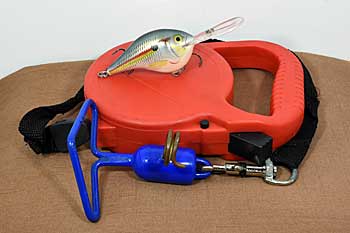
Many times, you can use your electronics to find good standing weeds. You can quickly see the condition of these by making a cast or two with a crankbait. Get your bait hooked in the weeds and bring up a sample. If the weeds are green and look alive, you're in the right area, but keep moving to find good green weeds if the weeds have a brown look. Also, pay attention to the outside edge of these weeds. Are there rocks located close by? If you have found rocks that butt up to the weeds, you have found something that you need to pay special attention to. Bass will use both the weeds and rock areas as feeding grounds during this season.
When making your crankbait picks, you want baits that will get down deep enough to contact the weeds and rocks, in this case. Also, pay attention to the action of your bait. When fishing on the edge of the weeds, you want a crankbait with a wide wobble action. This helps shed the weeds when breaking free from them, giving you a good viable retrieve. If the bait has weeds on it that you can't shed, it turns out to be a wasted cast.
I have found three baits that excel for this late-season weed pattern: Storm Magnum Wiggle Warts, SPRO Fat Pappa, and Rapala DTs. These baits complement each other as the Mag Wart comes equipped with rattles, but the Fat Pappa and DTs are silent baits.
Make your cast and start to reel your bait down, and when you make weed contact, act like you're setting the hook. This will break your bait free and get it on its way again.
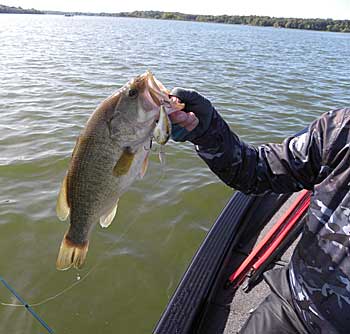
Pay special attention and try a few things. If you get the bait to break free, pause and let the bait sit for a 1-1000, 2-1000 count before you start to reel again. The bait sitting still for a second or two will often trigger a strike from a bass. If that does not generate a strike, start to reel your bait again until you contact the weeds again, then do the same thing.
Also, try reeling your bait down after a cast, and when you hit the weeds, give your bait a hook set action to break the bait free. When the bait breaks free, start to reel your bait again with no pause. I had had days when the bass wanted a pause or just wanted a constant moving bait. Let the bass tell you what they are looking for when generating strikes that day.
I fish the rocks in two diverse ways. I'll start by fishing the weed edges and hit the rocks when my bait gets deep enough on the retrieve. When the bass are inactive, they will be at the base of the weeds, either tucked in the weeds or sitting close on the weed/rock edge, waiting to ambush food that happens to venture by.
I'll also get on the weed edge and cast parallel to the weeds targeting the rock area outside of the weeds. This will keep my bait in the strike zone longer, often generating more strikes than fishing the other direction coming off the weed edge out to the rocks.
Southern Late Season Cranking
When the fall season starts to end, bass will get the signal when the shad start to make movements out of the back bays and start to move back to the main river channel areas. Most of the time, these moves are driven by shad spawning urges. If the bass want to eat, they will have to follow them. There will still be some food back in these back bay areas so that these movements won't be here one day gone the next.

Once out on the main area, bass will start to set up on river channel bends as this is the deepest water in the area. You can quickly look for these areas on your electronics maps. Take the time to idle a few of these areas, looking for signs of standing timber and bass holding in the area. The closer the channel swing gets to shore, the more bass and food will stack up in these corners. Pay close attention to these areas and check them well.
Like the bass using weeds in Northern waters, they will use standing timber on river channel bends as holding places in Southern reservoirs. I think most of this is driven by the shad and baitfish. The bass are driven by food location more than they will by the attraction to the cover.
Once you have found a few of these areas in your waters, it's time to break them down better. Idle over these areas and see if you can see schools of baitfish holding in the area. If yes, set up within casting distance. Note the depth of the baitfish on your electronics and use an appropriate crankbait to reach these depths.
I try to use a two-bait approach when fishing this pattern. I'll pick a bait that can get to just above the bass zone. I reason that bass will wait to target baitfish that get a little too far away from the school. They see this as easy prey. Thinking there is something wrong with the baitfish, I use this bait on my way to the main bait holding area. I can often get a few bass to commit to this crankbait fished on the fringe of the school.
Once I get on the edge of the baitfish, I'll switch to a bait that I can fish through the baitfish and work below them. Once again, I'm trying to use this single-bait mentality to help trigger strikes from bass. Try to use this instinct to your advantage in helping you trigger bites.
Southern Cranking Keys
You should pay attention to a few things when fishing in these conditions. The first is line choice. When I'm targeting areas outside or over the brush, I'll use a fluorocarbon line to get max depth out of my bait. Fluorocarbon has limited stretch and will get my bait a few feet deeper than if I used a monofilament line.
When targeting bass over the tops of the trees, I'll often switch to a monofilament line for the simple reason if I get my crankbait hung in the tree, I'll have a better chance of getting this bait back. Monofilament floats where fluorocarbon line sinks.
If I get a crankbait hooked in a treetop – and this is important – Do Not bury the hooks into the wood! I can sometimes get my crankbait back by putting slack in my line and letting the bait float back out of the cover. If that does not work, I can often get my bait back by using a crankbait retriever to knock it free.
Late Season Crankbait Tweaks
There are a few things that you can do to your crankbaits to make them more productive for late-season fishing.
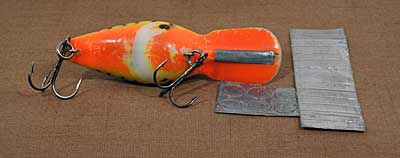
Lead Strips & Dots
Lead strips and dots are essential during your late-season fishing. On many of the baits that I'm using, I'll put a lead strip under the bill of the crankbait as this will change the angle of the lip as it sits in the water. This little trick gets my crankbait down to its maximum depth faster than a bait with an un-weighted lip. If I want the bait to pause a little longer in the bite zone, I'll add a dot to the belly of the body to hold my bait in the strike zone longer before starting to rise.
For me, the lead strip under the bill is an automatic addition to all my fall crankbaits. When it comes to the belly dots, I'll try one and see the results of this addition before using it on more baits. Let the bass tell you what they want first.
Sharp Hooks
When crankbait fishing, take the time to make sure your hooks are sharp during your day of fishing. Many times, at this point of the fishing season, bass will either push the bait or swat at your bait. Good sharp hooks will turn these moves into a bass over the side of the boat. Take the time to make sure your hooks are sharp during your time on the water.
Snaps
Some bass fishermen use them, and some don't. I always have a snap tied onto the end of my crankbait line. I feel a snap does not restrict the proper action of my crankbait, and I get better action from my crankbait when I use a snap. The biggest reason is it's easier and quicker to change baits when looking for strikes. I'll let you make the snap decision as it is a personal choice to use a snap or not, but I'm in the camp of using a snap when it comes to my crankbait fishing.
I hope these late-season crankbait tips will help you put more bass in your boat during the late-season period this year. As I stated, many bass fishermen believe you can't catch bass on crankbaits late into the fall/winter season. That is not true. You can still catch bass on crankbaits, but you will have to make critical adjustments along the way. I have laid out many of these adjustments in this article. I hope using these tactics will help you put more bass in your boat late into the season.
BassResource may receive a portion of revenues if you purchase using a link above.


